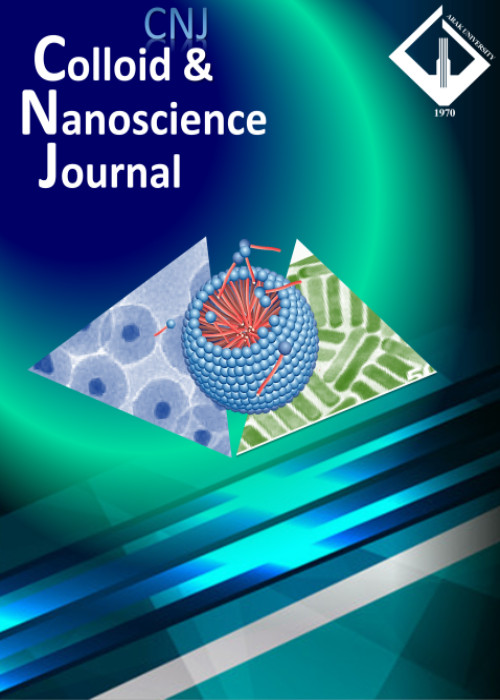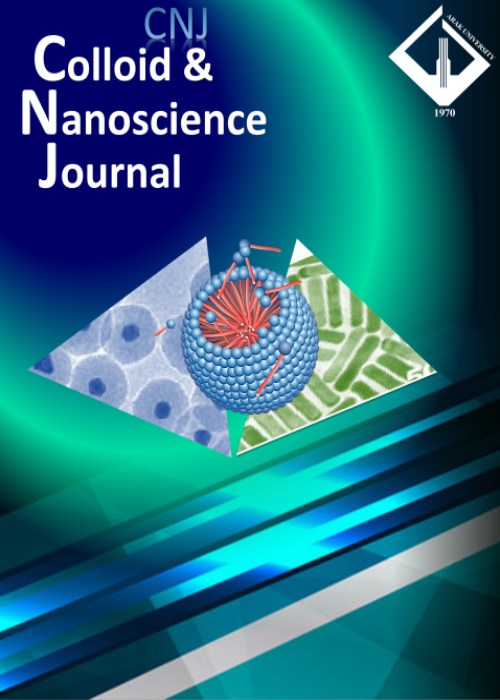فهرست مطالب

Colloid and Nanoscience Journal
Volume:1 Issue: 1, Mar 2023
- تاریخ انتشار: 1402/02/20
- تعداد عناوین: 6
-
Pages 1-6
In this paper nickel ferrite nanostructures fabricated via simple and green hydrothermal method using lemon juice. For the synthesis of NiFe2O4 nanoparticles, the materials were placed in the autoclave reactor for 2 and 12 hours. The morphology of particles was studied by scanning electron microscope (SEM). Although the NiFe2O4 nanoparticles after 2 h heating are agglomerated but increasing the heating time to 12 h leads to formation of sphere shape nano size particles. Crystal structure of nickel ferrite nanoparticles was investigated via X-ray diffraction pattern and crystallite size of particles was calculated using Debye-Scherrer formula. The magnetic hysteresis loop of the synthesized ferrite was studied by a vibration sample magnetometer (VSM). The magnetic parameters of remanance Mr, saturation magnetization Ms and coercivity Hc, increase as the synthesis time increases. The optical properties of NiFe2O4 were investigated by ultraviolet visible (UV-vis) spectra. The results show that the particles band gaps decreases with increasing the synthesis time.
Keywords: NiFe2O4, Hydrothermal, Lemon juice -
Pages 7-15
Thermal conductivity and viscosity of CuO/ethylene glycol/water, multi walled carbon nanotubes (MWCNT)/ethylene glycol/water and CuO/MWCNT/ethylene glycol/water nanofluid systems were determined experimentally at temperature range of 5 to 50oC and very low concentration (less than 0.008 vol.%). The obtained results show that the thermal conductivity of nanofluids significantly increases with increasing nanofluid temperature. It is also verified that the enhancement in thermal conductivity of nanofluid systems containing mixed CuO/MWCNT is more than systems containing CuO or MWCNT individually. Analyses of the viscosity data indicate that the viscosity diminishes with increasing temperature. The higher concentrations of all nanofluid systems possess higher viscosity. The results also show that the viscosity of nanofluid systems containing mixed CuO/MWCNT is between the viscosities of the systems containing CuO and MWCNT individually.
Keywords: Nanoparticle, Nanofluid, Thermal Conductivity, Viscosity mixed CuO, MWCNT -
Pages 16-25
Arrays of Co0.2Cux, with 0<x<0.1, nanowires (NWs) have been synthesized. CoCu NWs have been grown into the AAO templates by ac electrodeposition. The anodic aluminum oxide template (AAO) were synthesized by a two-step anodization process of pure Al foils in sulfuric acid. The effect of small addition of Cu to Co NWs by varying the concentrations of Cu+2 ions in the electrolyte, as well as the effect of annealing on the magnetic properties of NWs was investigated. Eventually, the effect of changing waveforms applied to nanowire deposition was studied. The results showed that the coercivity of cobalt NWs decreased by adding copper impurity as a non-magnetic material from 1337 Oe to 660 Oe. By annealing of the alloy NWs up to 450 °C, the coercivity increases from 1140 Oe value for pure Co NWs up to 1541 Oe for CoCu NWs due to the removal of structural stresses of the nanowire.
Keywords: CoCu alloys, Thermal annealing, Electrodeposition, Anodic aluminum oxide (AAO) templates -
Pages 26-38
The objectives of this DFT study are to consider the adsorption properties of the 4-[2-[4-(dimethylamino) phenyl] diazenyl]-benzoic acid (p-methyl red) dye molecule on the pristine B3O3 semiconducting layer for potential application in dye-sensitized solar cells. Adsorption of dye molecules on different positions of the B3O3 nanosheet leads to the formation of the complexes with favorable adsorption energy in the range of -0.25 to -1.48 eV and the 50 to 57% percentage of change in band gap energy of the monolayer. The dye molecule is adsorbed in two forms on the B3O3 surface, the complexes of the trans-isomer with a more negative adsorption energy of -1.48 eV being more stable than -1.41 eV of the cis-isomer complexes. By the adsorption of dye molecules on the pristine B3O3 surface, the electronic properties of the surface change a lot, which in this work can be proved with the percentage of the changes in the gap energy of more than 50%. The present study results show that the studied substrate may be suitable for application in dye-sensitized solar cells via pairing with a desired dye molecule.
Keywords: B3O3 monolayer, Solar cell, DSSC, DFT study -
Pages 39-50
In this article, the water-based Carbon nanotube (CNT) nanofluid in various CNT concentrations was used in an industrial shell and tube cooler as a cooling fluid. The heat transfer factors have been analyzed, such as Reynolds number, Nusselt number, overall heat transfer coefficient, and heat transfer rate. The cooling fluid flows on the tube side, and the hot fluid flows on the shell side. The CNT concentrations were 0.0055%, 0.055%, 0.111% and 0.278% volume fraction. The results represented that the heat transfer properties increased with CNT volume fraction as 0.278 CNT volume fraction enhanced the Nusselt number and the convection heat transfer coefficient about 47% and 59.3%, respectively, for example. Likewise, heat transfer was enhanced with the increment of the nanofluid mass flow rate for all the CNT volume concentrations.
Keywords: CNT nanofluid, Shell, tube cooler, Heat transfer coefficient, CNT volume fraction, Nanofluid Mass flow rate -
Pages 51-61
Double layer Cation Exchange Membranes (DLCEMs) have been prepared by surface polymerization of dopamine-co-POSS nanoparticles on a PVC based heterogeneous cation exchange membrane. FTIR and FESEM images proved relatively uniform forming of intended DLCEMs. The FESEM images illustrated almost integrity dispensation of nanoparticles through the surface layer. Results represented that developing nanocomposite layer resulted in surface hydrophilicity enhancement. The obtained data for Cu2+ and Cr2+ removal percentage for the prepared membranes represents higher capacity for DLCEMs to remove heavy metals compared to pristine cationic membrane. Also membranes showed higher Cr2+ removal capacity rather than Cu2+. The membrane surface modification by introducing PDA nanocomposite also caused to improving sodium permeability and flux. Furthermore, transport number and permselectivity of the prepared CEMs generally follow an increasing procedure nearly. It should be noticed that incorporation of POSS nanoparticles into the surface layer resulted in electrical resistance reduction obviously.
Keywords: Electrodialysis, Double layer Membrane, Electrochemical Characterization, Water Treatment


